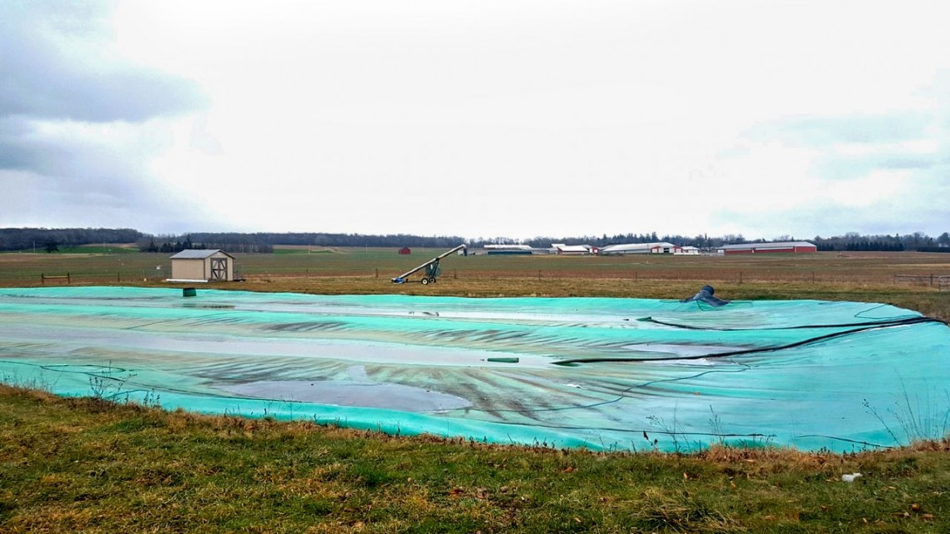Aug 14 2020
In a state-funded report commissioned by the New York State Department of Agriculture and Markets, two researchers from Cornell University state that New York agriculture has the potential to compensate for its own greenhouse gas (GHG) emissions.
 A manure cover and flare, pictured here on Fessenden Farm in King Ferry, New York, can improve water quality while also destroying methane. Image Credit: Tim Fessenden/Provided.
A manure cover and flare, pictured here on Fessenden Farm in King Ferry, New York, can improve water quality while also destroying methane. Image Credit: Tim Fessenden/Provided.
Titled “New York Agriculture and Climate Change: Key Opportunities for Mitigation, Resilience, and Adaptation,” the 65-page report offers a scientific evaluation of opportunities and barriers to climate adaptation and mitigation practices on New York’s farms.
It has been published in the wake of the Climate Leadership and Community Protection Act, signed into law by Governor Andrew Cuomo last year. According to this law, all sectors of society should mitigate 40% of their GHG emissions by 2030, and 85% by 2050.
This report provides a pathway for farmers, policymakers and citizens to increase productivity and the greenhouse gas mitigation of the land while also attempting to ensure a less variable climate for future farmers.
Jenifer Wightman, Research Associate, Soil and Crop Sciences Section, School of Integrative Plant Science, College of Agriculture and Life Sciences, Cornell University
Wightman is the first author of the report.
In an industrialized state like New York, we need every sector to step up and make a contribution to mitigating climate change. There’s the opportunity to do that with agriculture and forestry while also getting other benefits” such as improved profitability and cleaner air and water, he said.
Peter Woodbury, Senior Research Associate, Soil and Crop Sciences Section, School of Integrative Plant Science, College of Agriculture and Life Sciences, Cornell University
Woodbury is the co-author of the report.
People tend to focus mainly on carbon emissions, but according to the authors, it is crucial to account for three greenhouse gases generated on farms: carbon dioxide, nitrous oxide, and methane.
“It’s not commonly known, but methane and nitrous oxide account for 75% of agricultural emissions,” noted Wightman, adding that compared to carbon dioxide, methane is 84 times more potent and nitrous oxide is 264 times more potent as a GHG, which makes them significant targets for mitigation.
The report determined practices that eliminate GHGs more steadily from the atmosphere, in contrast to temporary fixes. According to the researchers, planting trees can sequester carbon for hundreds of years if they are harvested for building materials that tend to store carbon for the entire lifetime of the structure.
Because climate change is a 100-, 300-, 1,000-year project, we want to make sure that we’re supporting projects that lead to permanent greenhouse gas emission reductions and aren’t just temporary.
Jenifer Wightman, Research Associate, Soil and Crop Sciences Section, School of Integrative Plant Science, College of Agriculture and Life Sciences, Cornell University
In the report, the researchers have added a table that classifies 13 mitigation opportunities based on the level at which they could be executed, and whether they fulfilled crucial criteria.
The acronym SMART—which stands for “services” or co-benefits of an action; whether an approach is “measurable,” “achievable,” and “realistic” to execute; and whether the action offers a more stable mitigation “time” frame—sums up these standards.
Following are the top five SMART mitigation actions:
- Manure storage cover and flare—Storage units reduce the spread of manure in winter months, thus enhancing water quality. However, they tend to produce methane. The produced methane can be eliminated by adding a cover to collect it and adding a flare. These systems can last up to two decades, are priced at $300,000, and eliminate huge amounts of methane, thus rendering it a cost-effective GHG mitigation for society. But it incurs a high cost per individual farm.
- Nitrogen management—Although nitrogen inputs promote plant growth, its ineffective use leads to the emission of nitrous oxide. Optimization of nitrogen use saves related costs, can increase yields, and bring down the emissions of ammonia and nitrous oxide.
- Livestock feed management—Enhancement of feed efficiency leads to reduced feed costs and brings down cow methane emissions, while increasing milk production and reducing manure. All of the above minimize GHG emissions.
- Woodland management—Over 21% (around1.4 million acres) of farmlands are wooded. Protection, maintenance, and management of woodlands can help farms to conserve and improve this crucial New York state carbon sink, while producing useful hardwood timber to support the college education of a child or retirement.
- Activation of underutilized lands—Nearly 1.7 million acres of former or underutilized farmland in New York state could be utilized for producing bioenergy, solar arrays, and/or growing new forests. All these provide different mechanisms of GHG mitigation and rural economic development.
In addition, Wightman and Woodbury have also penned a companion report titled “Sources and Sinks of Major Greenhouse Gases associated with New York State’s Natural and Working Lands: Forests, Farms, and Wetlands” (2020), which has been commissioned by the New York State Energy Research and Development Authority.